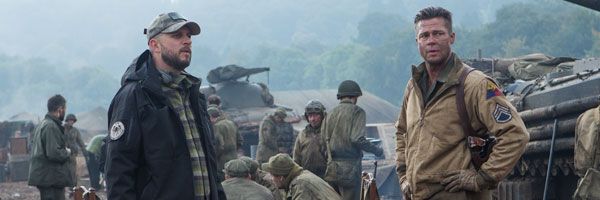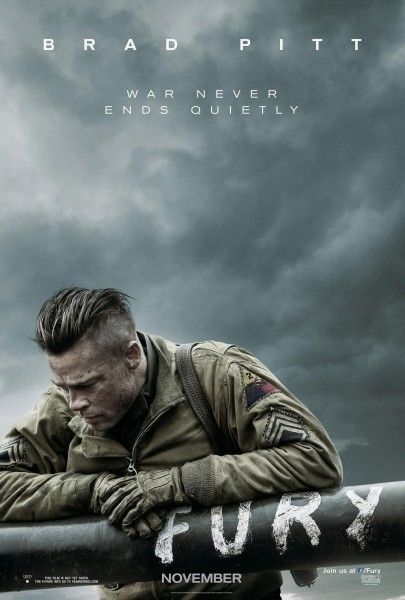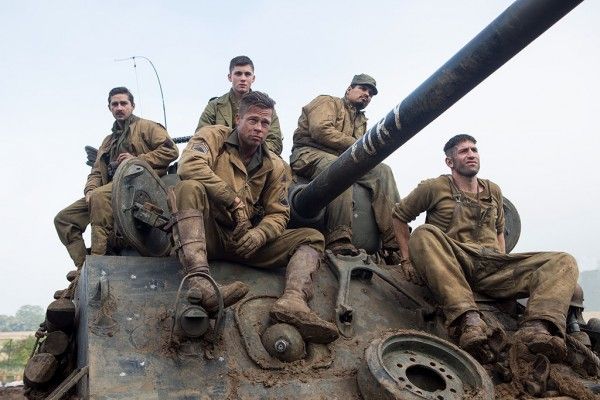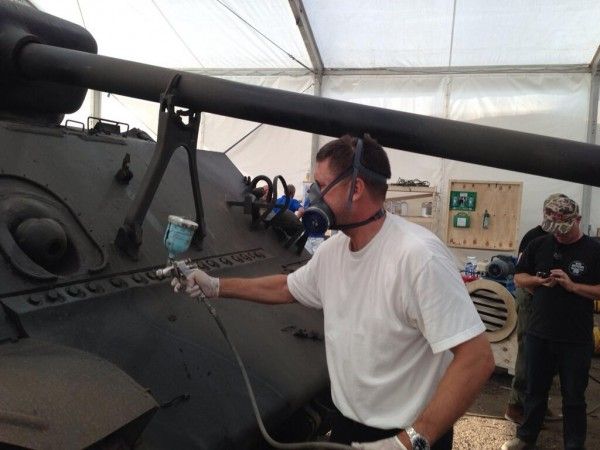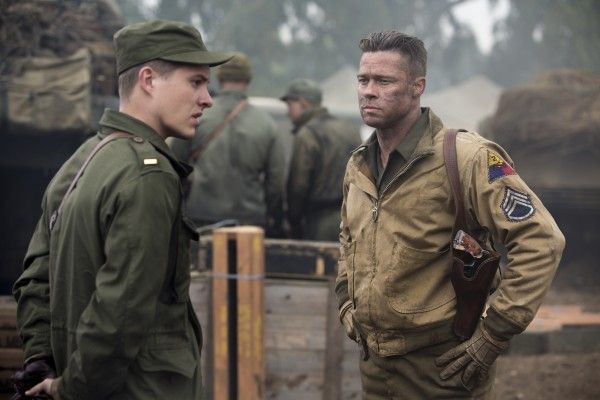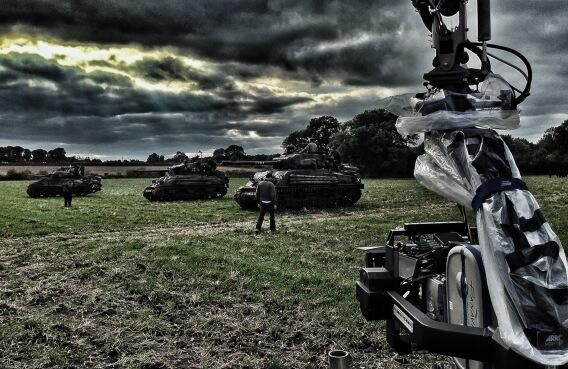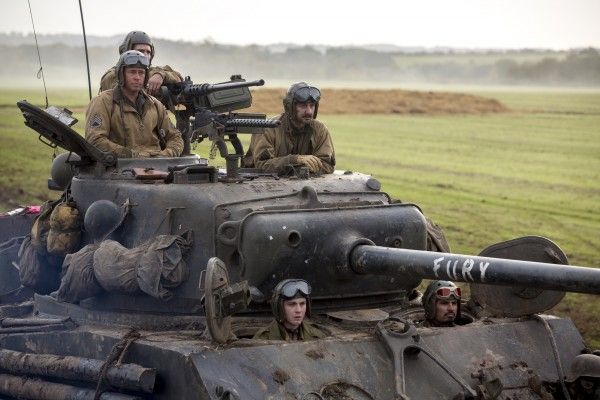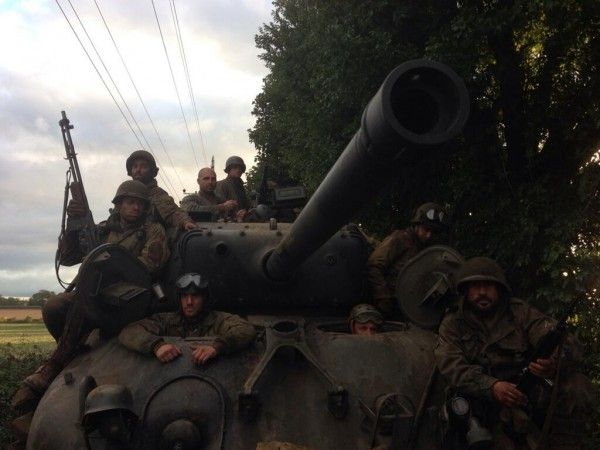One of the things I like about David Ayer movies (End of Watch, Training Day) is the authenticity. Whether he writes or directs the project, he manages to inject real characters into whatever situation is unfolding onscreen, and in his latest movie, Fury, Ayer is using his talents to tell a new World War II movie about a Sherman tank crew. Featuring an all-star cast (Brad Pitt, Shia LaBeouf, Logan Lerman, Michael Pena, Jon Bernthal, and Jason Isaacs), Fury takes place at the end of the War where a battle-hardened group face overwhelming odds trying to strike at the heart of Nazi Germany.
Last year, when the production was filming in harsh conditions outside London, I got to visit the set with a few other reporters. While I walked in looking forward to the film, I left blown away by what Ayer was doing on set and how committed the cast and crew were to making a special movie. Not only was the film trying to be as realistic as possible by using real tanks and props, Ayer had been working on the script and idea for years and some of the people I spoke to said it was his best work yet. Since Ayer was incredibly busy on set, he didn't have time for an interview. But a few days ago I participated in a group phoner where Ayer talked about wanting to tell a different kind World War II movie, the cast boot camp, using real tanks, the editing process, how Sony loves the movie and is letting him do some additional photography to add a bit more action, and a lot more. Hit the jump for the interview.
Before going any further, if you haven't seen the Fury trailer, I'd watch that first.
Question: What's the biggest thing that has changed for you in your perception of the film since shooting?
DAVID AYER: Wow. This is going to be very director-y as far light continuity on the set. Our light was primarily the sun and you don't want it to look cloudy. We actually managed to cut together the film quite well and it looks beautiful. The look of the film really held up. But that's a very director-y comment. As far as the DNA of the actual film, it's grown into something that's a lot more emotional than I thought it would be.
I saw in the featurette that you're using a lot of cranes and fluid shots. I know from your earlier films that you tend to use a lot of shakycam and handheld shots. How do you feel about the adjustment from ground-level shooting to a more expanse, pre-planned shoot?
AYER: Right. Well, the big problem with cranes is that I'm not a big fan of pretentious shots. What we did with cranes was basically use them in the same way a Dolly would work. Because of the conditions we were shooting in and the height of these tanks, we needed to have the extension and the reach to get to areas that would be more labor-intensive to build platforms and drop Dolly track. So it's very traditionally shot in the tradition of older films. I studied a lot of newsreel footage from the war in order to replicate a lot of the look and feel. I really just shoot it. If you look at Harsh Times, which is my first film, you'll see it's very measured in the way it's shot, also. I only really got the shakycam moniker after End of Watch, which was a found footage movie. But every movie is different. Every movie requires its own sort of photographic voice.
One of the things I think a lot of people are going to think is that you guys went to some kind of Hollywood soundstage and created these tanks and created a lot of equipment that you use. On set we learned that you used actual World War II props, actual tanks and a very, very special actual German tank.
AYER: Well, it's a big insurance bill, that's for sure. You can't just store the stuff in a break room. But it was great to be able to get the wartime tanks. Tanks from all over Europe. The owners were kind enough to let us weld them, paint them and get them into the exact configurations they were in during the end of the war. The Bovington Tank Museum, after extended negotiations, let us use a type of tank that has never been in a feature before. It's the only running German Tiger tank in the world. To have a battle with a real Tiger and real Sherman tanks coming at each other with pyro blowing off and explosions and everything -- It was a once in a lifetime experience.
Can you tell me a little about your military background?
AYER: Well, I'm a Veteran. I was in the Navy, in the submarine corps. I come from a military family. Both of my grandparents were in World War II and retired as officers. Once fought in the Pacific and one fought in Europe. The whole family was in the war. I grew up exposed to it and hearing the stories, but the stories I heard weren't kind of the whole "Rah, rah, rah! We saved the world!" They were about the personal price and the emotional price. The pain and the loss are the shadows that sort of stalk my family. That was something that I wanted to communicate with people. Even though it was literally a fight of good against evil and it had an incredibly positive outcome, the individual man fighting it was just as tired, scared and freaked out as a guy operating a base in Afghanistan or a guy in the jungle in Vietnam.
How did Brad Pitt come to be involved with this?
AYER: He got his hands on the script and he wanted to do it. It was pretty straightforward. He read it and, I think, fell in love with the character. He read it fast. It all unfolded very quickly. He was ready for total immersion and he was ready to play this troubled, complex guy who outwardly doesn't seem like the best guy. But then you get to know him and you start to understand the true loneliness of having other peoples' lives in your hands. You're responsible for people and have to keep them alive. And sometimes you've got to send them to their deaths while others live. He captures that darkness.
Can you talk a little about the boot camp that you made the actors go through?
AYER: Yeah, it was basically run by feel. There's kind of no one more knowledgable in the dark art of training than making soldiers and shipping the mind. It was fully immersive. Day one, everyone threw their cellphone in a helmet. Brad was first, to set the example. It was full on. It was 24 hours a day. There was no "Hey, let's give the actors a break" stuff. It was fully full-on. It was incredibly intense psychologically and, at the end of the day, it wasn't about, "Let's all learn to be soldiers". It was about making these guys bond as a family by putting them through one of the more intense experiences of their lives together. They will always share that. They will always have that in common.
How long was the boot camp?
AYER: It was a week.
Sort of to that same point, how do you get the actors to start pulling together as their characters?
AYER: It's kind of everything. If you want to know somebody, fight 'em. Have a fistfight with them. We did a lot of sparring and combatives and martial arts. Then there's also extensive training with the weapons and the vehicles. To operate the tank as a crew, it's not about five individuals. It has to be one organism, composed of five people. Forcing them to learn how to operate a tank and having them work together -- Putting Brad in this leadership position. Then just lots and lots and lots and lots of rehearsal. It's full-contact rehearsal. It's not just a bunch of guys sitting in chairs in a room reading scenes. It's guys in the mud, in the tank. On top of the tank. Moving ammo boxes. Learning new scenes. There's a cumulative effect and it shows. They really bonded.
There was an incident with some scenes that were shot on Remembrance Day. Can you talk about what happened there?
AYER: Yeah, absolutely. I woke up in the morning and there was all this negative UK press. I was like, "What the fuck is going on?" I immediately issued an apology and I was really sorry it happened. Once I drilled down a bit and understood what was going on, it made more sense. We wrapped at 2am that night. Saturday night. We were shooting Saturday night and wrapped at 2am. Part of the story had us driving tanks all over the countryside. None of that happened. No tank was moving. We weren't operating tanks. Nobody told us to stop. We had all the permissions and everything. Everything was good to go and I just got thrown under the bus by some background people who were just disgruntled or something. It was kind of heartbreaking because I'm a veteran. It just gave the wrong impression of what the movie's about and what I'm about.
Can you talk a little about the editing process? Where are you at right now? What have you learned from any friends and family screenings?
AYER: I would say that, from the screenings, we learned that we have something special. You never know what you have until you put it in front of an audience. That's the truth. That's the truth of filmmaking and that's why you make movies, for an audience to, hopefully, enjoy it. In this case, there's an incredible release that happens when you realize you have something unique, something special, something powerful and something different. As far as where we're at right now? The beast's back is broken. Now it's just polish on the final touches. Work on the music. Work on the visual effects. Fine-tune scenes. Make it as good as it can be. My mantra is "Better is better". Just anything I can do to make it better until they drag me out of the editing room.
It seems like one of the really unique perspectives this movie is offering is that it's not just World War II, it's a single day in a very specific period at the very, very end of the war.
AYER: Yeah, exactly. It's sort of the American knocked out version of World War II is like: Japanese bomb Pearl Harbor, we saved Private Ryan and a sailor kissed a nurse in Times Square. It was a brutal slog, especially at the end of the war. The movie takes place four weeks before the war ends. You're fighting a fanatical enemy. I drew a lot of parallels between the fanaticism of Nazi Germany and the fanaticism of Al-Queda or something like that. They're just as committed and you had the equivalent of suicide bombers. They were hanging children. They were grabbing kids -- thirteen year old kids -- and putting uniforms on them. They were giving them weapons and sending them after tanks. If they didn't do it, they'd hang them. There's something about the fanaticism and the brutality of fighting an enemy like that. For a lot of World War II veterans, it's actually the most disturbing and difficult part of the war for them. Going into Germany and seeing these things happen. No one has really told that story.
There were talks about how reshoots are planned for next month. What's the story with those?
AYER: Yeah, it's additional photography. I'm just banging away some more action stuff. Let's put it this way. Sony loved the movie and they're like, "What do you want?" I said, "More action!" They were like, "Here you go!" So I'm going to go blow some stuff up!" (laughs)
You have a release date of November 14, just at the start of Award season. Have you thought about premiering it at a festival like Telluride?
AYER: I don't know. If it's happening, I'm not the guy to know. Right now, I've got my nose the grindstone and I kind of just lock myself in a dark room and work on the movie. I let the world do what the world does.
I remember being on-set and seeing all the reference photos in black and white. Was there ever any thought to making the film in black and white?
AYER: It's funny. Yeah, I definitely used those things to inspire the look of the film and I went to great pains to take a look at the actual photographs of the time and not remake someone else's movie and not base my look off someone else's World War II movie look. Experimentally, people didn't live it in black and white. When we do look at color material from the war, it's really emotional. It's really impactful. The look I'm going for in the film isn't that washed-out "look, it's the past" look. When you talk to people who have been in combat, there's a sensory overload that happens. The color becomes vivid. Sounds become more pronounced. People talk about how, for them, the war was technicolor and real life was black and white after the war. That's a little bit of what I want to capture.
Are you still attached to the remake of Commando?
AYER: I'm not involved with that anymore.
Could you talk about working with Shia?
AYER: I love the guy. I think he's freaking fantastic. What he did was become, a little bit, my BS detector. I'd be like, "Go do this" and he'd say, "No man, I'm not doing that." (laughs) "Why not?" "Well, I don't know. I don't know if this is real or not." And I'd go, "Whoa. You're right. Lemme rethink that." He came at things from such an emotionally deep and honest place that he actually became a great barometer for digging in and finding out a little bit more truth about these characters. It's that thing of him being a real, living, breathing person, who's really cool. Then there's this public perception of who he is. He's a child actor trying to get out of that mold. He's trying to basically destroy his own history so he can be rediscovered for who and what he is, which is a brilliant actor. I think people are going to be shocked by what he brings to the table.
When we look at your filmography, it's all very "tough" films. Do you have, say, a romantic comedy side that we haven't seen, or is that just not in you?
AYER: I think it's in me. I think a good director can embrace any genre and it's the kind of thing where you always want to do something different. You always want to challenge yourself. For me, everything's on the table.
For more from my Fury set visit:

